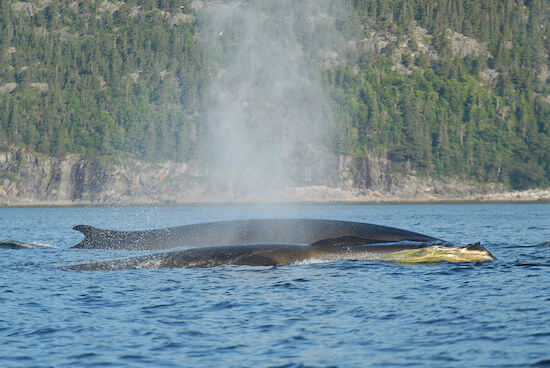In calm weather, the spouts of large rorquals can be heard hundreds of metres away, but above all, they can be seen for miles! © GREMM
With their powerful, eye-catching blasts, large rorquals are not going unnoticed by observers this week.
On June 25, off the Gaspé coast, a whale-watching cruise operator witnesses a series of large spouts. Six humpbacks dive, all quite close to one another. A few days earlier, he had recognized two of them: Irisept and Bolt. During three trips out to sea, he observed two blue whales. Are they the same individuals? Throughout the week, he crossed paths with minke whales and fin whales as well.
Also in the Gaspé, our collaborator René Roy, who participates in MICS’ photo-identification work for large rorquals, also had the chance to admire “clusters of spouts” (article in French). For him, such a dense gathering of large rorquals comes as a surprise. What brings them to congregate in such large numbers? Since whales come to the St. Lawrence in summer to feed, it can be assumed that food was plentiful in the region this week. He also spotted two mother-calf duos: a pair of humpbacks and a pair of minke whales.
Despite what it may seem, not all whales are in the Gaspé! In Sept-Îles, one observer was able to see swarms of krill on the surface. And the whales seem to have taken advantage! A dozen or so fin whales are observed 5 nautical miles off the island of Corossol, near Sept-Îles. At least two humpbacks also passed through the sector this week. One observer recognized “Petite Fleur”, a humpback that earned its moniker due to its unusual, triangle-shaped tail. The other individual is probably a newcomer to the sector. He also observed seven or eight minke whales swimming along the coast. In his view, their presence might be attributable to capelin. Groups of harbour porpoises and gannets have also arrived in the Lower North Shore. It can therefore be assumed that the sector is teeming with herring and mackerel, which are important prey for these two species.
Over the weekend, Tic Tac Toe and Snowball passed by Les Bergeronnes. The observer recognizes them by their characteristic caudal fins: Tic Tac Toe has a lot of white and a large black X, while Snowball’s tail is almost entirely black with just two small white spots. They have not been seen again since. On the other hand, a new humpback whale seems to have arrived in the area! On June 25, this same observer also notes the presence of a few belugas and minke whales. The same day from the pier in Port-au-Persil, ten or so belugas are seen in the direction of Saint-Siméon.





